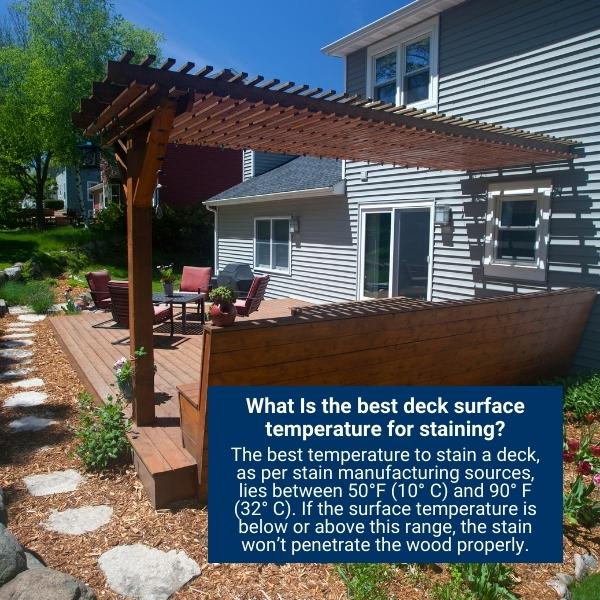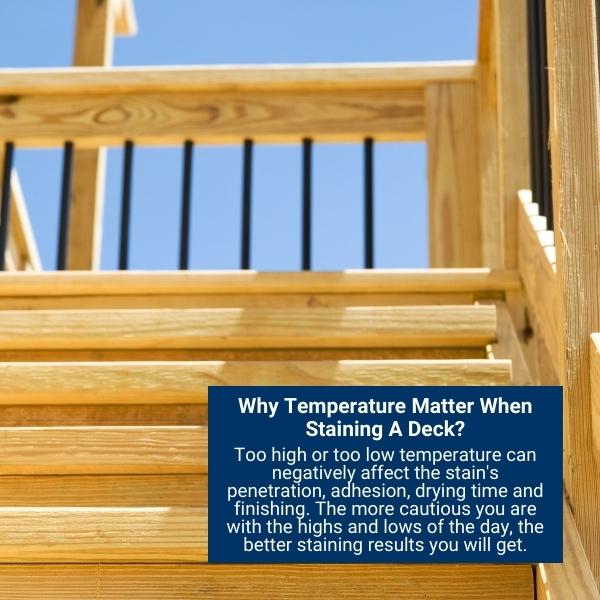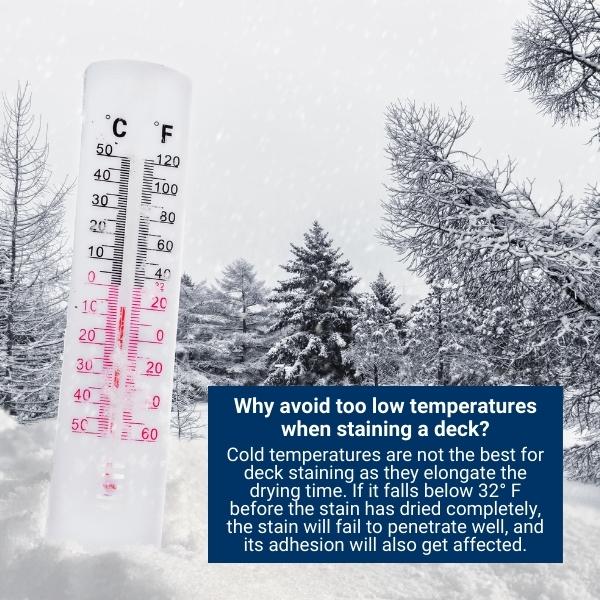If you have installed a deck, you might know how easily it starts to look old and shabby without proper care. Therefore, staining the wooden structure every three to four years is crucial.
However, before applying the stain, you must choose the perfect day for the task, neither too hot nor too cold. Also, you may wonder, what is the ideal temperature of deck staining?
The best temperature range to apply stain to the deck is between 50 and 90 degrees F. An extremely hot or cold day can result in uneven absorption, drying and curing of the stain. Check the forecast and pick a day when no rain is expected in the next 24 hours.
Cleaning and staining the deck on time can make your outdoor space look as good as new. In this guide, I’ll discuss the ideal temperature to stain the deck and what kind of weather conditions you must avoid for better results.
What Is The Ideal Temperature To Stain A Deck?
Adding an appealing outdoor space such as a deck is something we all cherish from the core of our hearts. There is no arguing about how installing a deck elevates the whole look of your home. But, to keep it maintained and nice looking, this wooden structure requires cleaning and staining once in a while.

Staining the deck helps in protecting it against damage and decay, a common issue with outdoor spaces. The ideal temperature to stain a deck, as per stain manufacturing sources, lies between 50°F (10° C) and 90° F (32° C). Many don’t realise that this temperature range points to the highs and lows of the day and the temperature of the wood surface you want to stain.
Also Read: Kreg Deck Jig Vs Camo? Which One To Use And Where?
Deck Surface Temperature:
Now, it can be possible that a sunny day within the 70° F range can raise the deck surface temperature beyond 90° F. If you apply stain to the deck at such time, you might have to face a lot of application challenges.
Similarly, if the surface temperature is below the minimum, it will mess with the staining process. The temperature must stay above 50° F until the stain is cured, including consistent overnight temperatures.
Best Time To Stain A Deck:
The ideal time to stain a deck is when the forecast shows at least three to four days in a row with a temperature between 40° F (4° C) and 80° F (27° C). The four-day period is enough for cleaning, drying, and curing the stain. If the first coat is dry to the touch, you can also apply a second coat within four hours, as some manufacturers suggest.
Does Temperature Matter When Staining A Deck?
The temperature has a crucial role to play when it comes to applying a deck stain. As mentioned above, the suggested temperature for deck staining is fairly wide, giving a lot more room for error. Different regions have varying highs and lows, allowing you to pick the temperature that best suits the geographical conditions of the deck location.
Also Read: Should A Deck Be Level Or Sloped? Detailed Answer!

However, if you exceed beyond the said range and apply the deck stain at too low a temperature, it directly affects the curing process of the stain. Likewise, coating the deck with stain at a high temperature will cause it to evaporate and dry waymore quicker.
In both situations, the stain application gets messed up, and ultimately it fails to protect the deck wood as you wanted. Thus, performing staining when the day falls within the ideal temperature range (45- 95 degrees F) is important.
Suggestions To Find The Best Deck Staining Temperatures:
If you plan to apply the deck stain yourself, choosing a day ideal for the process might confuse you. Apart from the ideal temperature, weather conditions such as rain, humidity and wind also can affect the results.
To make it easier, I have a few handy suggestions for you to stain your deck effectively. Let’s read!
Avoid Too-High Temperatures:
Days with extremely high temperatures are not suitable for stain application. That’s because when it is too hot, the stain tends to dry faster than usual, leading to uneven wood penetration and leaving lap marks.
Also Read: Best Decking Material For Winter: A Detailed Guide!

So, avoid staining the deck at any cost when the temperature hits above 90° F.
On warm sunny days, both the air temperature and the wood surface are burning hot. Never apply the deck during this period as it is dangerous for you as well as for the performance of the stain.
To be safer, ensure to pick a cooler day or stain the deck in the morning when it’s not that hot. Once the stain has been applied and started to dry, it is fine if the temperature rises afterwards.
Avoid Too Low Temperatures:
Cold temperatures are still not the best for deck staining as they elongate the drying time. If you have to stain your deck when it’s spring or fall, wait until the temperature rises above 50° F. furthermore, check the forecast for the night to ensure there is no risk of the temperature dropping to the freezing level.
If it falls below 32° F before the stain has dried completely, it will cause a hindrance in the curing process. The stain will fail to penetrate well, and its adhesion will also get affected.

Also Read: How To Lay Decking On Grass? Step By Step Guide!
Direct Sunlight Is A Big NO-NO:
Regardless of the temperature outside (warm or cold), avoid applying stain to the deck during peak sunlight hours. The exposure to direct sunlight results in flash drying of the stain means it can no longer penetrate the wood properly, and its longevity decreases.
Moreover, flash drying also gives a blotchy, uneven appearance, leaving you with no option but to start the whole process all over again.
Avoid Rain And Intense Humidity:
Besides temperature, humid weather is also not suitable for deck staining, it doesn’t affect the stain’s performance, but the more intense the humidity, the longer the stain will take to dry fully. Similarly, staining the deck on rainy days makes no sense.
Always check the forecast for the next twenty-four hours to see if there are any showers predicted or not. An unexpected rain will wash the stain away, and you don’t want this to happen.
Avoid The Windy Days:
The wind brings many uninvited guests, such as leaves, twigs or other debris, to your freshly stained deck. All these things can stick to the wet wooden surface or leave unwanted imprints in the applied stain. So better avoid windy days rather than dealing with the after-mess.
Wrap Up:
The best wood surface and air temperature to stain your deck fall between 70 to 75 degrees F. Apart from temperature, humidity also has to be around 40% or 50% for better stain application. Too high or too low temperature and intense humidity can negatively affect the stain’s penetration, adhesion, drying time and finishing.
Thus, proper stain application at the right temperature is necessary to keep the deck protected and improve its appearance. The more cautious you are with the highs and lows of the day, the better staining results you will get.
FAQs:
Can You Stain The Deck In The Winter?
Most of the deck stains you find must not be applied at a temperature below 50 or above 90. As the temperature can fall below the 50 mark during winter, it is suggested not to apply the stain these days. You will have to wait until spring or early fall when the temperature is within the recommended range.
How Late In The Year Can I Stain My Deck?
You can stain some newly installed decks soon after project completion, but this is not an ideal criterion. For most decks, the best time to stain the lumber is when it is thoroughly dried. Ideally, the deck requires a waiting of 3 weeks to 12 months to dry before you can stain it.

